Roman History Timeline: A Chronological Overview - CLST103 Assignment
VerifiedAdded on 2022/08/27
|12
|1435
|35
Homework Assignment
AI Summary
This assignment presents a chronological timeline of 15 significant events in Roman history, spanning from the founding of Rome in 753 BC to the death of Theodosius in 395 AD. The timeline covers pivotal moments such as the Law of the Twelve Tables, major battles like Cannae and Actium, the assassination of Julius Caesar, and the Great Fire of Rome. Each event is briefly described, providing context and highlighting its importance in shaping the Roman Republic and Empire. The document showcases key figures, political shifts, and military conflicts that defined the rise and fall of Rome, offering a concise yet informative overview of its historical trajectory. This student submission is available on Desklib, a platform providing study resources.

Running head: CHRONOLOGY
CHRONOLOGY
Name of the Student
Name of the University
Author Note
CHRONOLOGY
Name of the Student
Name of the University
Author Note
Paraphrase This Document
Need a fresh take? Get an instant paraphrase of this document with our AI Paraphraser
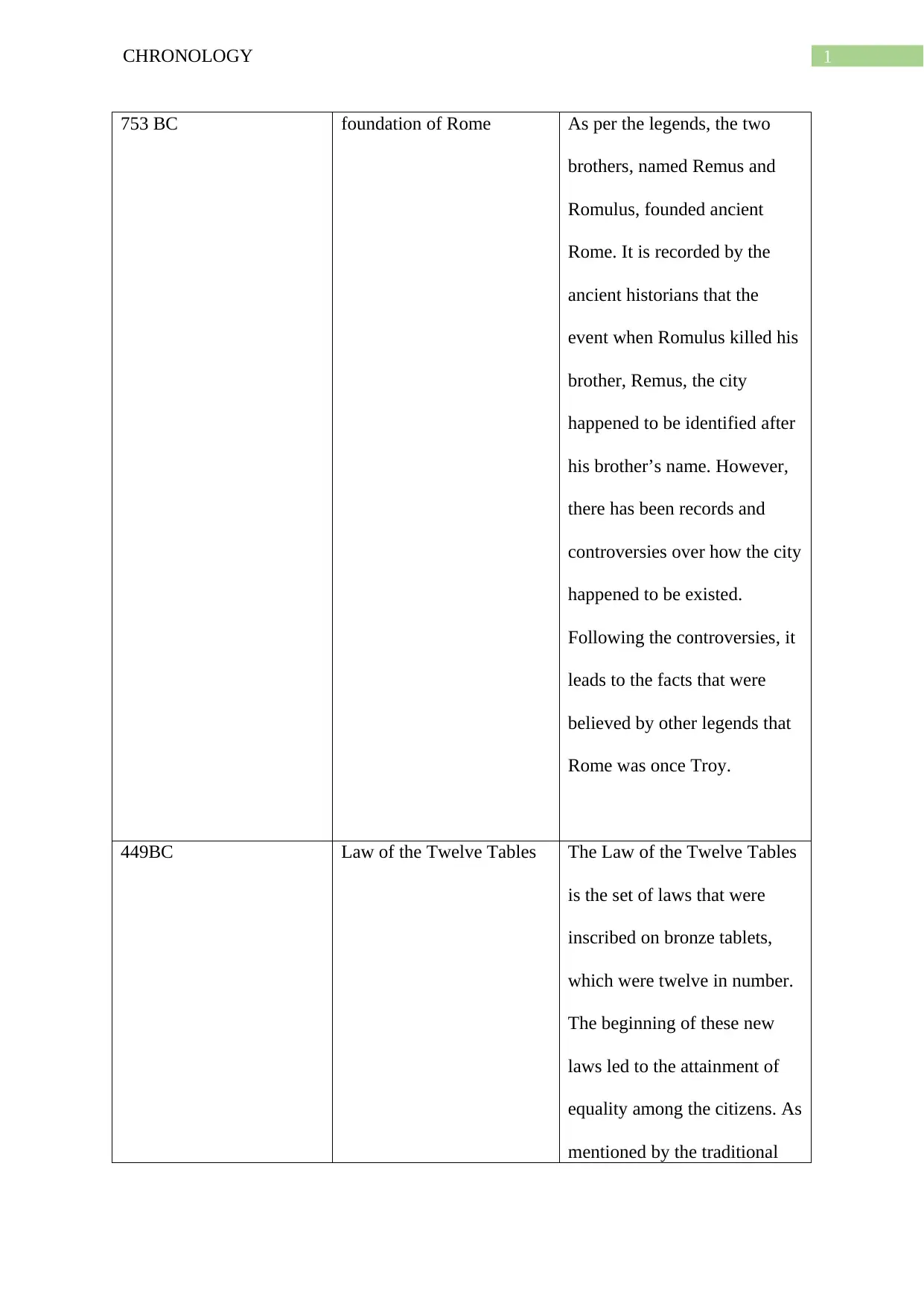
1CHRONOLOGY
753 BC foundation of Rome As per the legends, the two
brothers, named Remus and
Romulus, founded ancient
Rome. It is recorded by the
ancient historians that the
event when Romulus killed his
brother, Remus, the city
happened to be identified after
his brother’s name. However,
there has been records and
controversies over how the city
happened to be existed.
Following the controversies, it
leads to the facts that were
believed by other legends that
Rome was once Troy.
449BC Law of the Twelve Tables The Law of the Twelve Tables
is the set of laws that were
inscribed on bronze tablets,
which were twelve in number.
The beginning of these new
laws led to the attainment of
equality among the citizens. As
mentioned by the traditional
753 BC foundation of Rome As per the legends, the two
brothers, named Remus and
Romulus, founded ancient
Rome. It is recorded by the
ancient historians that the
event when Romulus killed his
brother, Remus, the city
happened to be identified after
his brother’s name. However,
there has been records and
controversies over how the city
happened to be existed.
Following the controversies, it
leads to the facts that were
believed by other legends that
Rome was once Troy.
449BC Law of the Twelve Tables The Law of the Twelve Tables
is the set of laws that were
inscribed on bronze tablets,
which were twelve in number.
The beginning of these new
laws led to the attainment of
equality among the citizens. As
mentioned by the traditional
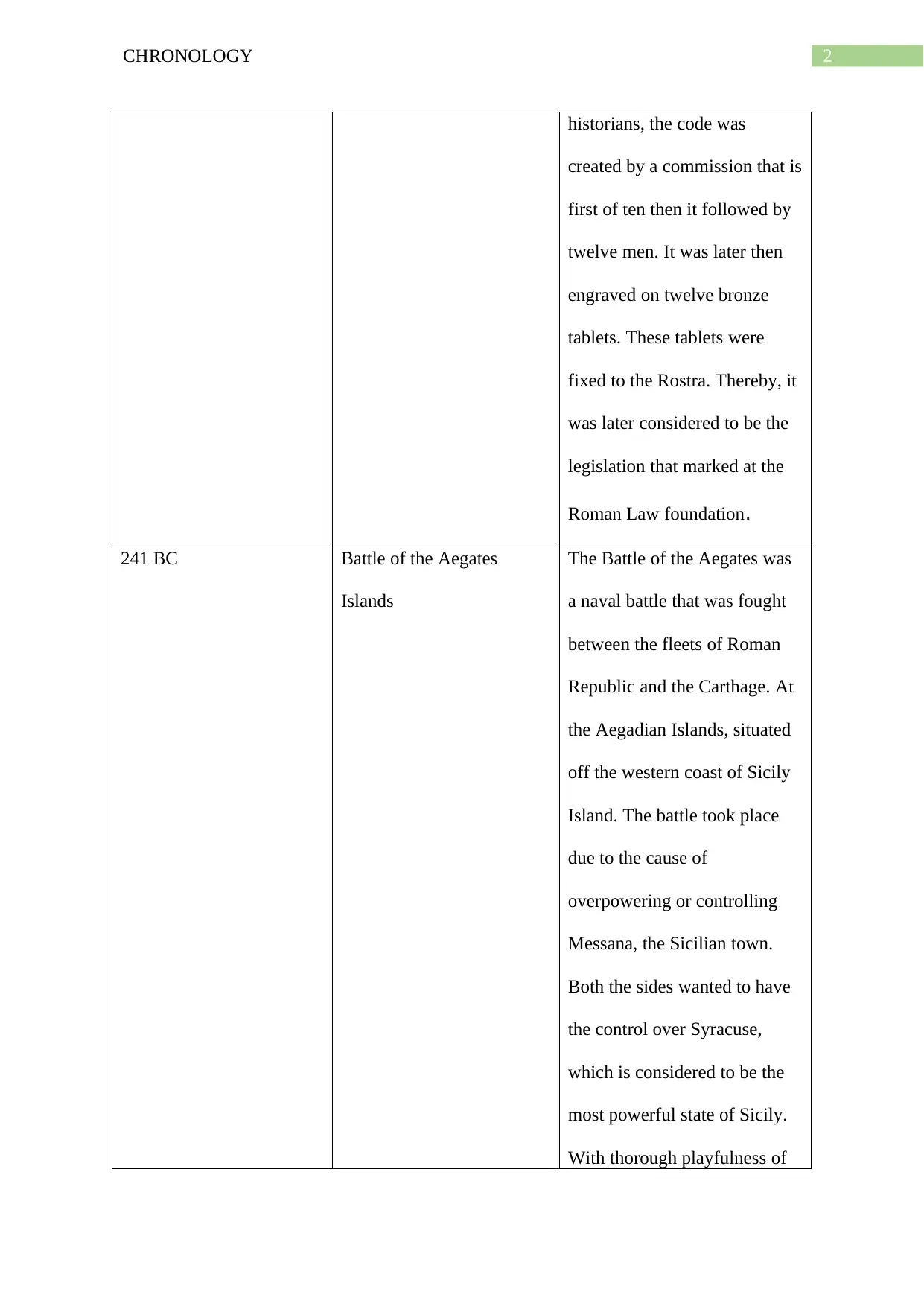
2CHRONOLOGY
historians, the code was
created by a commission that is
first of ten then it followed by
twelve men. It was later then
engraved on twelve bronze
tablets. These tablets were
fixed to the Rostra. Thereby, it
was later considered to be the
legislation that marked at the
Roman Law foundation.
241 BC Battle of the Aegates
Islands
The Battle of the Aegates was
a naval battle that was fought
between the fleets of Roman
Republic and the Carthage. At
the Aegadian Islands, situated
off the western coast of Sicily
Island. The battle took place
due to the cause of
overpowering or controlling
Messana, the Sicilian town.
Both the sides wanted to have
the control over Syracuse,
which is considered to be the
most powerful state of Sicily.
With thorough playfulness of
historians, the code was
created by a commission that is
first of ten then it followed by
twelve men. It was later then
engraved on twelve bronze
tablets. These tablets were
fixed to the Rostra. Thereby, it
was later considered to be the
legislation that marked at the
Roman Law foundation.
241 BC Battle of the Aegates
Islands
The Battle of the Aegates was
a naval battle that was fought
between the fleets of Roman
Republic and the Carthage. At
the Aegadian Islands, situated
off the western coast of Sicily
Island. The battle took place
due to the cause of
overpowering or controlling
Messana, the Sicilian town.
Both the sides wanted to have
the control over Syracuse,
which is considered to be the
most powerful state of Sicily.
With thorough playfulness of
⊘ This is a preview!⊘
Do you want full access?
Subscribe today to unlock all pages.

Trusted by 1+ million students worldwide
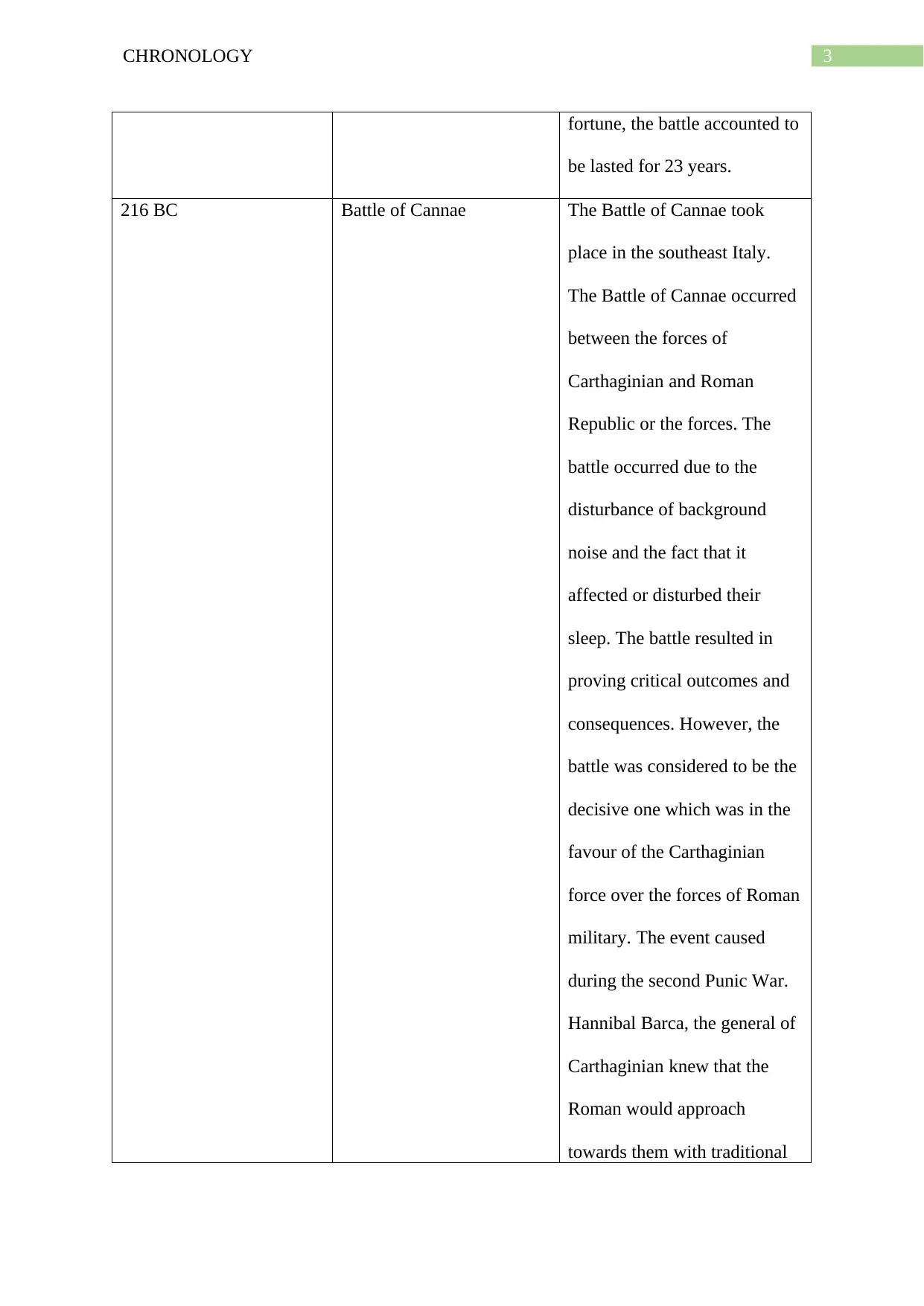
3CHRONOLOGY
fortune, the battle accounted to
be lasted for 23 years.
216 BC Battle of Cannae The Battle of Cannae took
place in the southeast Italy.
The Battle of Cannae occurred
between the forces of
Carthaginian and Roman
Republic or the forces. The
battle occurred due to the
disturbance of background
noise and the fact that it
affected or disturbed their
sleep. The battle resulted in
proving critical outcomes and
consequences. However, the
battle was considered to be the
decisive one which was in the
favour of the Carthaginian
force over the forces of Roman
military. The event caused
during the second Punic War.
Hannibal Barca, the general of
Carthaginian knew that the
Roman would approach
towards them with traditional
fortune, the battle accounted to
be lasted for 23 years.
216 BC Battle of Cannae The Battle of Cannae took
place in the southeast Italy.
The Battle of Cannae occurred
between the forces of
Carthaginian and Roman
Republic or the forces. The
battle occurred due to the
disturbance of background
noise and the fact that it
affected or disturbed their
sleep. The battle resulted in
proving critical outcomes and
consequences. However, the
battle was considered to be the
decisive one which was in the
favour of the Carthaginian
force over the forces of Roman
military. The event caused
during the second Punic War.
Hannibal Barca, the general of
Carthaginian knew that the
Roman would approach
towards them with traditional
Paraphrase This Document
Need a fresh take? Get an instant paraphrase of this document with our AI Paraphraser
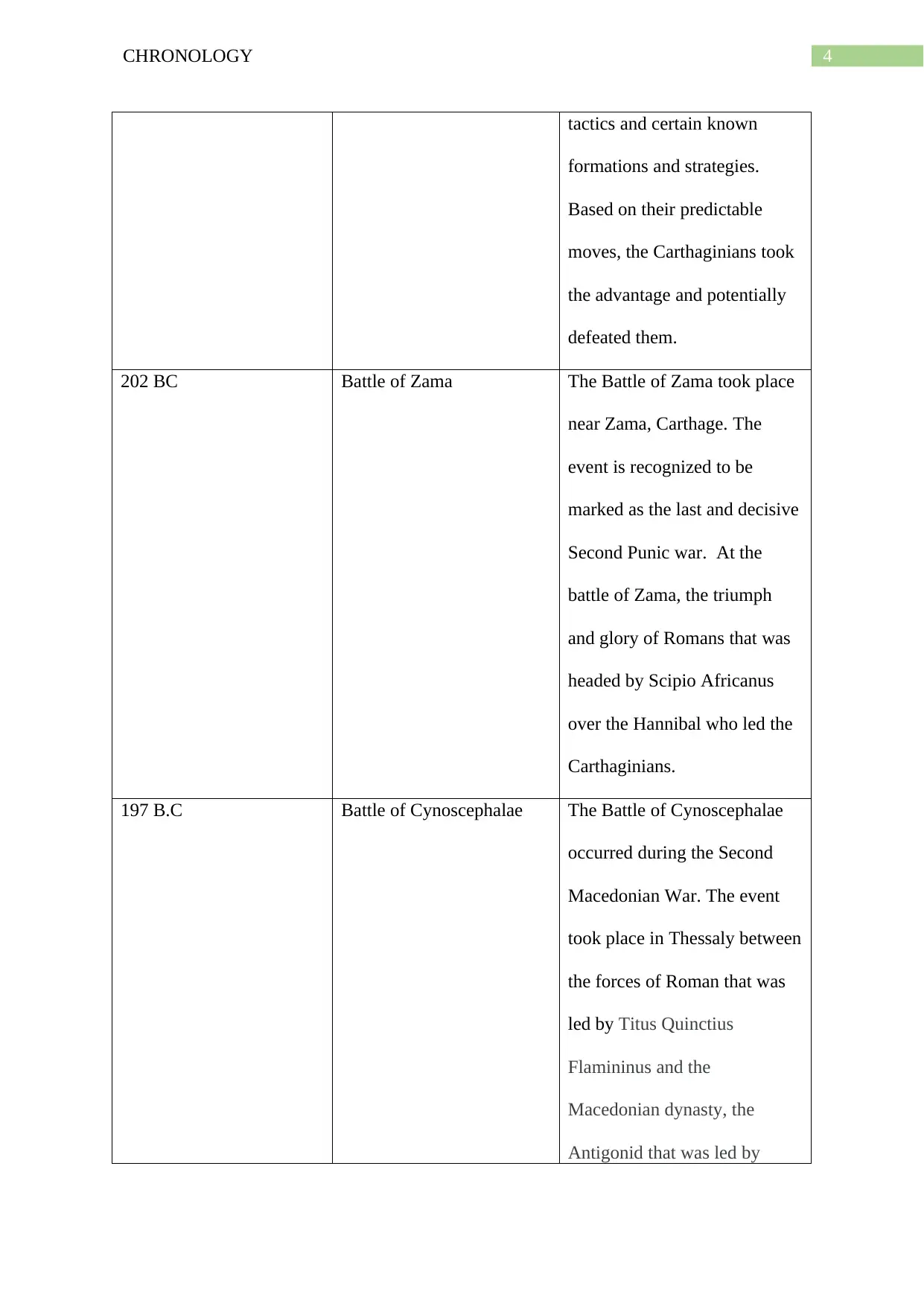
4CHRONOLOGY
tactics and certain known
formations and strategies.
Based on their predictable
moves, the Carthaginians took
the advantage and potentially
defeated them.
202 BC Battle of Zama The Battle of Zama took place
near Zama, Carthage. The
event is recognized to be
marked as the last and decisive
Second Punic war. At the
battle of Zama, the triumph
and glory of Romans that was
headed by Scipio Africanus
over the Hannibal who led the
Carthaginians.
197 B.C Battle of Cynoscephalae The Battle of Cynoscephalae
occurred during the Second
Macedonian War. The event
took place in Thessaly between
the forces of Roman that was
led by Titus Quinctius
Flamininus and the
Macedonian dynasty, the
Antigonid that was led by
tactics and certain known
formations and strategies.
Based on their predictable
moves, the Carthaginians took
the advantage and potentially
defeated them.
202 BC Battle of Zama The Battle of Zama took place
near Zama, Carthage. The
event is recognized to be
marked as the last and decisive
Second Punic war. At the
battle of Zama, the triumph
and glory of Romans that was
headed by Scipio Africanus
over the Hannibal who led the
Carthaginians.
197 B.C Battle of Cynoscephalae The Battle of Cynoscephalae
occurred during the Second
Macedonian War. The event
took place in Thessaly between
the forces of Roman that was
led by Titus Quinctius
Flamininus and the
Macedonian dynasty, the
Antigonid that was led by
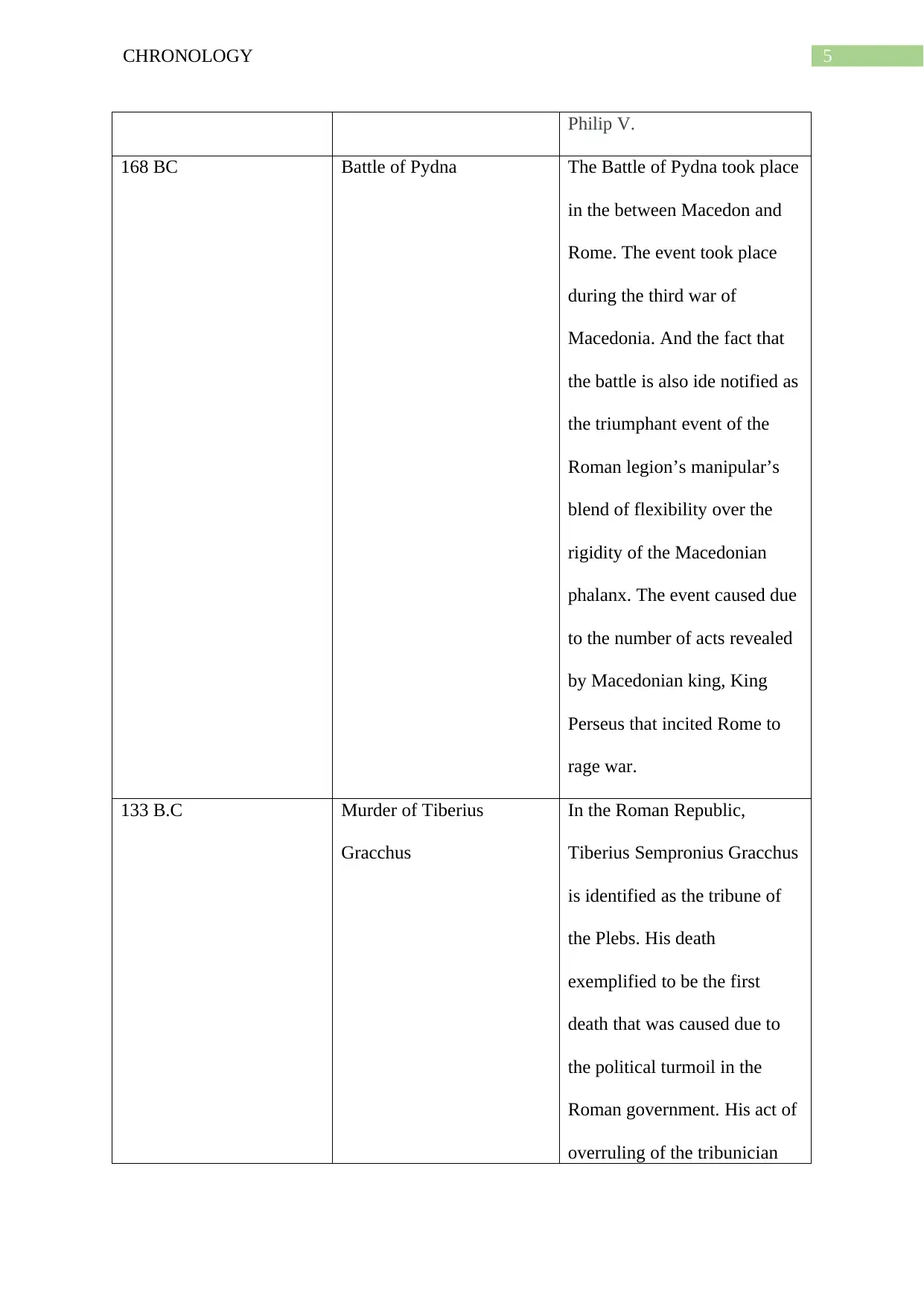
5CHRONOLOGY
Philip V.
168 BC Battle of Pydna The Battle of Pydna took place
in the between Macedon and
Rome. The event took place
during the third war of
Macedonia. And the fact that
the battle is also ide notified as
the triumphant event of the
Roman legion’s manipular’s
blend of flexibility over the
rigidity of the Macedonian
phalanx. The event caused due
to the number of acts revealed
by Macedonian king, King
Perseus that incited Rome to
rage war.
133 B.C Murder of Tiberius
Gracchus
In the Roman Republic,
Tiberius Sempronius Gracchus
is identified as the tribune of
the Plebs. His death
exemplified to be the first
death that was caused due to
the political turmoil in the
Roman government. His act of
overruling of the tribunician
Philip V.
168 BC Battle of Pydna The Battle of Pydna took place
in the between Macedon and
Rome. The event took place
during the third war of
Macedonia. And the fact that
the battle is also ide notified as
the triumphant event of the
Roman legion’s manipular’s
blend of flexibility over the
rigidity of the Macedonian
phalanx. The event caused due
to the number of acts revealed
by Macedonian king, King
Perseus that incited Rome to
rage war.
133 B.C Murder of Tiberius
Gracchus
In the Roman Republic,
Tiberius Sempronius Gracchus
is identified as the tribune of
the Plebs. His death
exemplified to be the first
death that was caused due to
the political turmoil in the
Roman government. His act of
overruling of the tribunician
⊘ This is a preview!⊘
Do you want full access?
Subscribe today to unlock all pages.

Trusted by 1+ million students worldwide
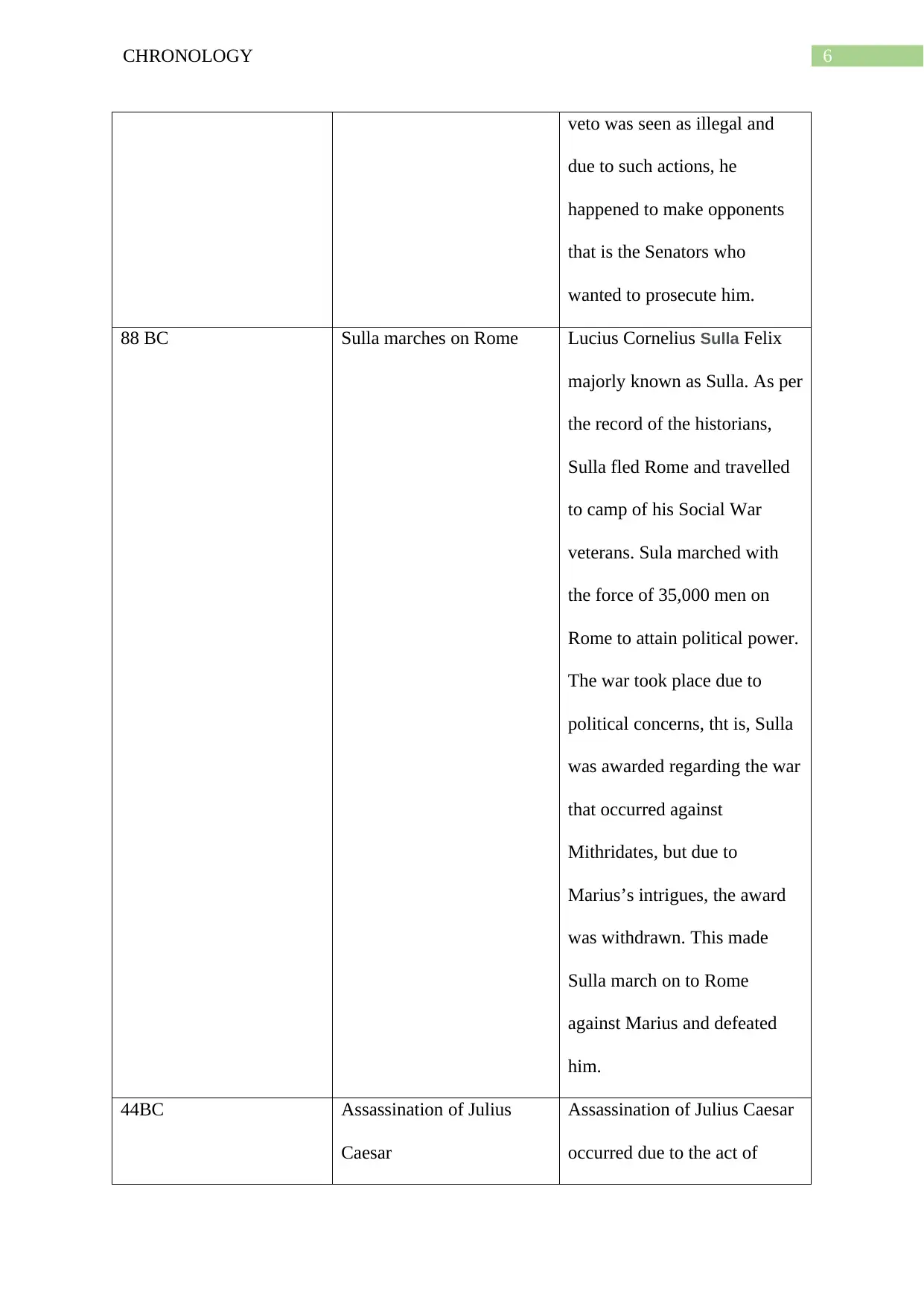
6CHRONOLOGY
veto was seen as illegal and
due to such actions, he
happened to make opponents
that is the Senators who
wanted to prosecute him.
88 BC Sulla marches on Rome Lucius Cornelius Sulla Felix
majorly known as Sulla. As per
the record of the historians,
Sulla fled Rome and travelled
to camp of his Social War
veterans. Sula marched with
the force of 35,000 men on
Rome to attain political power.
The war took place due to
political concerns, tht is, Sulla
was awarded regarding the war
that occurred against
Mithridates, but due to
Marius’s intrigues, the award
was withdrawn. This made
Sulla march on to Rome
against Marius and defeated
him.
44BC Assassination of Julius
Caesar
Assassination of Julius Caesar
occurred due to the act of
veto was seen as illegal and
due to such actions, he
happened to make opponents
that is the Senators who
wanted to prosecute him.
88 BC Sulla marches on Rome Lucius Cornelius Sulla Felix
majorly known as Sulla. As per
the record of the historians,
Sulla fled Rome and travelled
to camp of his Social War
veterans. Sula marched with
the force of 35,000 men on
Rome to attain political power.
The war took place due to
political concerns, tht is, Sulla
was awarded regarding the war
that occurred against
Mithridates, but due to
Marius’s intrigues, the award
was withdrawn. This made
Sulla march on to Rome
against Marius and defeated
him.
44BC Assassination of Julius
Caesar
Assassination of Julius Caesar
occurred due to the act of
Paraphrase This Document
Need a fresh take? Get an instant paraphrase of this document with our AI Paraphraser
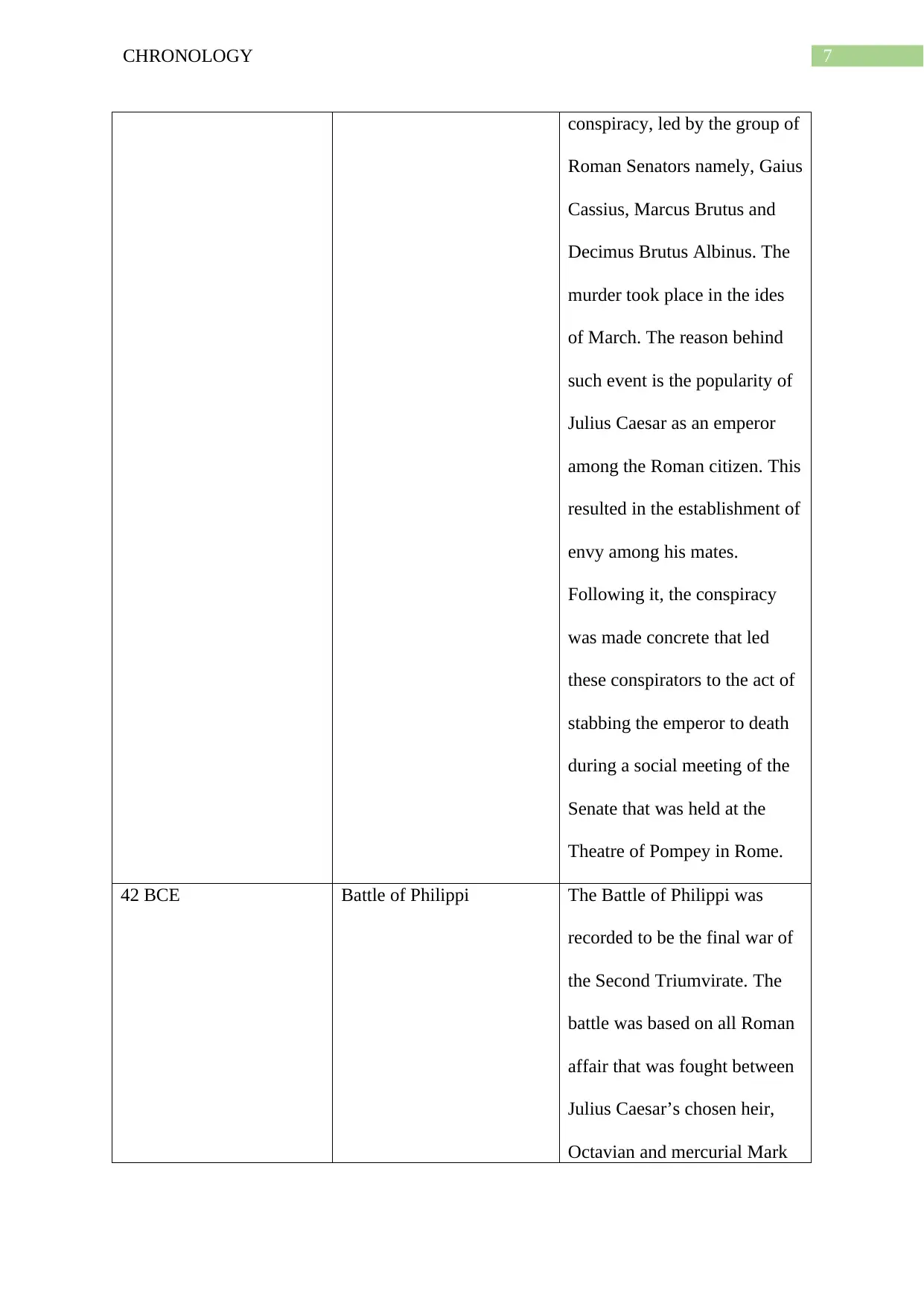
7CHRONOLOGY
conspiracy, led by the group of
Roman Senators namely, Gaius
Cassius, Marcus Brutus and
Decimus Brutus Albinus. The
murder took place in the ides
of March. The reason behind
such event is the popularity of
Julius Caesar as an emperor
among the Roman citizen. This
resulted in the establishment of
envy among his mates.
Following it, the conspiracy
was made concrete that led
these conspirators to the act of
stabbing the emperor to death
during a social meeting of the
Senate that was held at the
Theatre of Pompey in Rome.
42 BCE Battle of Philippi The Battle of Philippi was
recorded to be the final war of
the Second Triumvirate. The
battle was based on all Roman
affair that was fought between
Julius Caesar’s chosen heir,
Octavian and mercurial Mark
conspiracy, led by the group of
Roman Senators namely, Gaius
Cassius, Marcus Brutus and
Decimus Brutus Albinus. The
murder took place in the ides
of March. The reason behind
such event is the popularity of
Julius Caesar as an emperor
among the Roman citizen. This
resulted in the establishment of
envy among his mates.
Following it, the conspiracy
was made concrete that led
these conspirators to the act of
stabbing the emperor to death
during a social meeting of the
Senate that was held at the
Theatre of Pompey in Rome.
42 BCE Battle of Philippi The Battle of Philippi was
recorded to be the final war of
the Second Triumvirate. The
battle was based on all Roman
affair that was fought between
Julius Caesar’s chosen heir,
Octavian and mercurial Mark
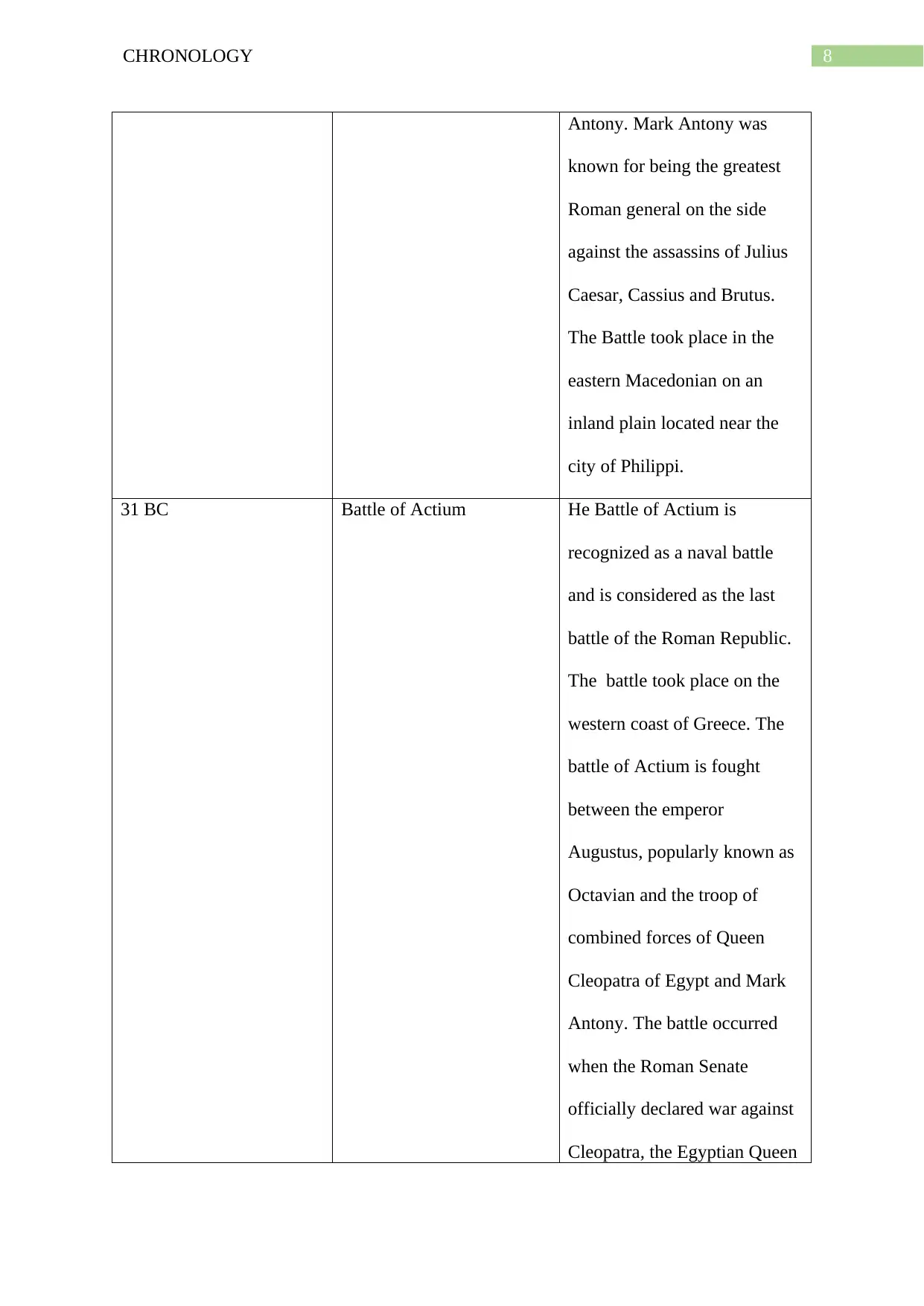
8CHRONOLOGY
Antony. Mark Antony was
known for being the greatest
Roman general on the side
against the assassins of Julius
Caesar, Cassius and Brutus.
The Battle took place in the
eastern Macedonian on an
inland plain located near the
city of Philippi.
31 BC Battle of Actium He Battle of Actium is
recognized as a naval battle
and is considered as the last
battle of the Roman Republic.
The battle took place on the
western coast of Greece. The
battle of Actium is fought
between the emperor
Augustus, popularly known as
Octavian and the troop of
combined forces of Queen
Cleopatra of Egypt and Mark
Antony. The battle occurred
when the Roman Senate
officially declared war against
Cleopatra, the Egyptian Queen
Antony. Mark Antony was
known for being the greatest
Roman general on the side
against the assassins of Julius
Caesar, Cassius and Brutus.
The Battle took place in the
eastern Macedonian on an
inland plain located near the
city of Philippi.
31 BC Battle of Actium He Battle of Actium is
recognized as a naval battle
and is considered as the last
battle of the Roman Republic.
The battle took place on the
western coast of Greece. The
battle of Actium is fought
between the emperor
Augustus, popularly known as
Octavian and the troop of
combined forces of Queen
Cleopatra of Egypt and Mark
Antony. The battle occurred
when the Roman Senate
officially declared war against
Cleopatra, the Egyptian Queen
⊘ This is a preview!⊘
Do you want full access?
Subscribe today to unlock all pages.

Trusted by 1+ million students worldwide
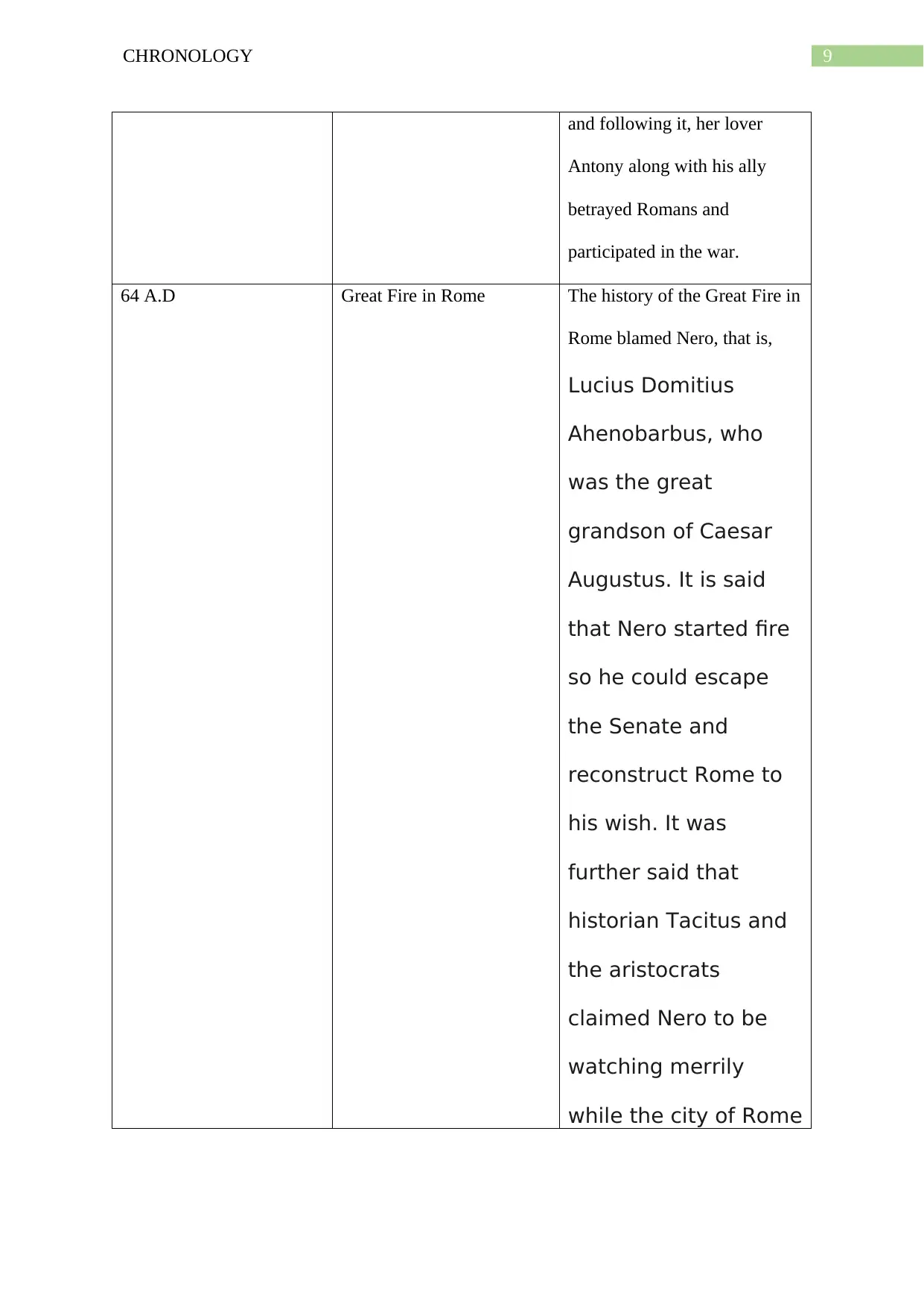
9CHRONOLOGY
and following it, her lover
Antony along with his ally
betrayed Romans and
participated in the war.
64 A.D Great Fire in Rome The history of the Great Fire in
Rome blamed Nero, that is,
Lucius Domitius
Ahenobarbus, who
was the great
grandson of Caesar
Augustus. It is said
that Nero started fire
so he could escape
the Senate and
reconstruct Rome to
his wish. It was
further said that
historian Tacitus and
the aristocrats
claimed Nero to be
watching merrily
while the city of Rome
and following it, her lover
Antony along with his ally
betrayed Romans and
participated in the war.
64 A.D Great Fire in Rome The history of the Great Fire in
Rome blamed Nero, that is,
Lucius Domitius
Ahenobarbus, who
was the great
grandson of Caesar
Augustus. It is said
that Nero started fire
so he could escape
the Senate and
reconstruct Rome to
his wish. It was
further said that
historian Tacitus and
the aristocrats
claimed Nero to be
watching merrily
while the city of Rome
Paraphrase This Document
Need a fresh take? Get an instant paraphrase of this document with our AI Paraphraser
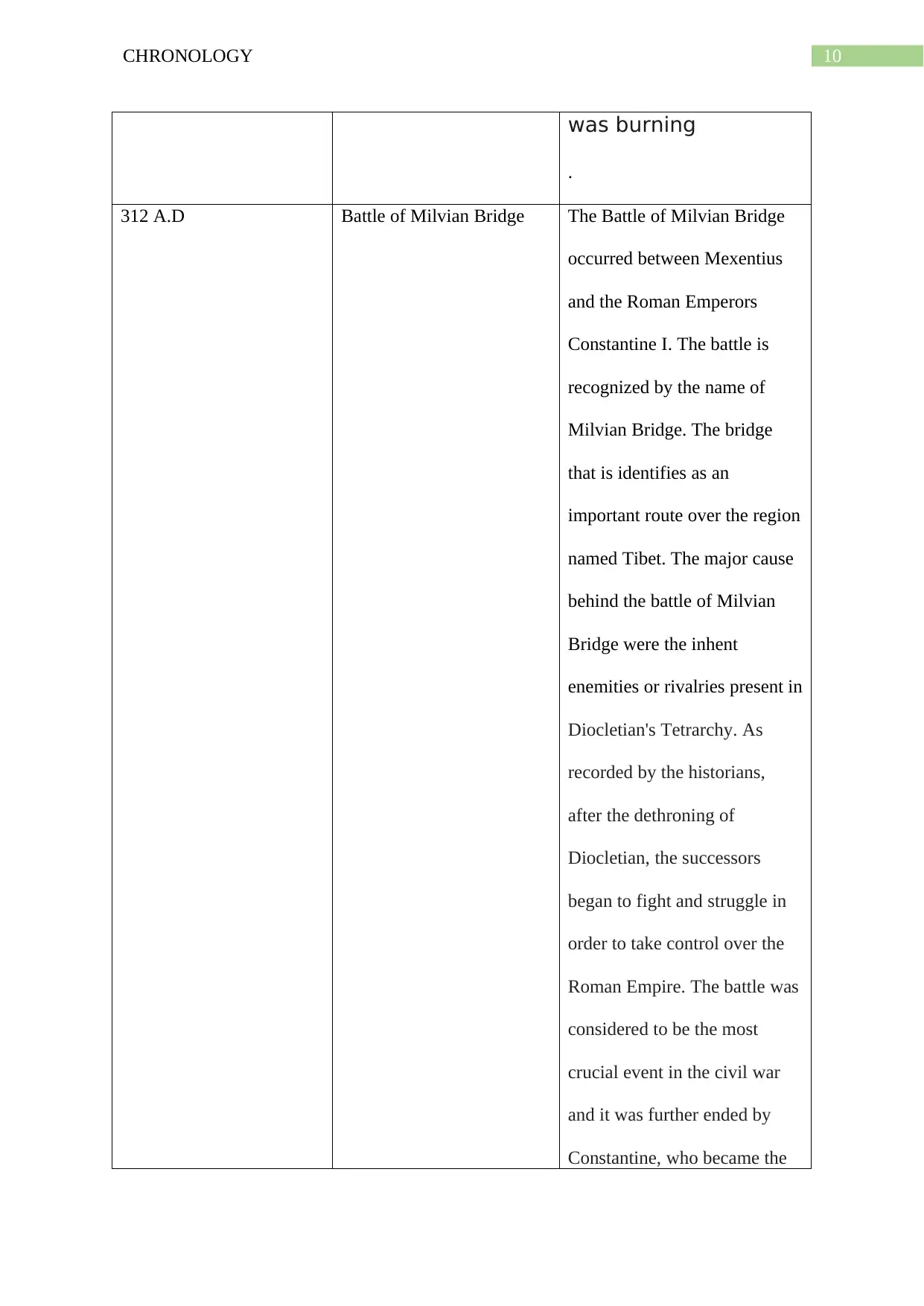
10CHRONOLOGY
was burning
.
312 A.D Battle of Milvian Bridge The Battle of Milvian Bridge
occurred between Mexentius
and the Roman Emperors
Constantine I. The battle is
recognized by the name of
Milvian Bridge. The bridge
that is identifies as an
important route over the region
named Tibet. The major cause
behind the battle of Milvian
Bridge were the inhent
enemities or rivalries present in
Diocletian's Tetrarchy. As
recorded by the historians,
after the dethroning of
Diocletian, the successors
began to fight and struggle in
order to take control over the
Roman Empire. The battle was
considered to be the most
crucial event in the civil war
and it was further ended by
Constantine, who became the
was burning
.
312 A.D Battle of Milvian Bridge The Battle of Milvian Bridge
occurred between Mexentius
and the Roman Emperors
Constantine I. The battle is
recognized by the name of
Milvian Bridge. The bridge
that is identifies as an
important route over the region
named Tibet. The major cause
behind the battle of Milvian
Bridge were the inhent
enemities or rivalries present in
Diocletian's Tetrarchy. As
recorded by the historians,
after the dethroning of
Diocletian, the successors
began to fight and struggle in
order to take control over the
Roman Empire. The battle was
considered to be the most
crucial event in the civil war
and it was further ended by
Constantine, who became the
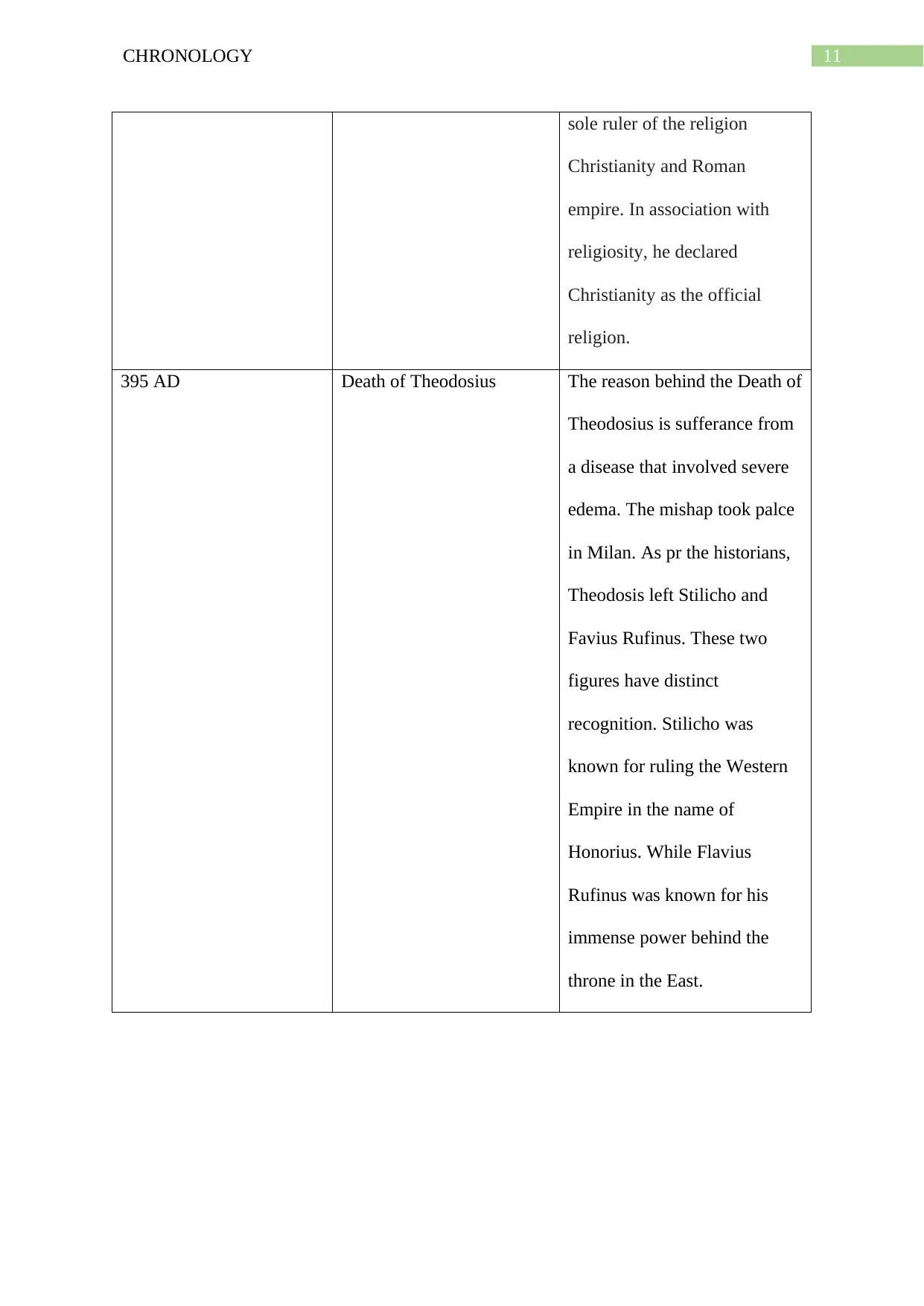
11CHRONOLOGY
sole ruler of the religion
Christianity and Roman
empire. In association with
religiosity, he declared
Christianity as the official
religion.
395 AD Death of Theodosius The reason behind the Death of
Theodosius is sufferance from
a disease that involved severe
edema. The mishap took palce
in Milan. As pr the historians,
Theodosis left Stilicho and
Favius Rufinus. These two
figures have distinct
recognition. Stilicho was
known for ruling the Western
Empire in the name of
Honorius. While Flavius
Rufinus was known for his
immense power behind the
throne in the East.
sole ruler of the religion
Christianity and Roman
empire. In association with
religiosity, he declared
Christianity as the official
religion.
395 AD Death of Theodosius The reason behind the Death of
Theodosius is sufferance from
a disease that involved severe
edema. The mishap took palce
in Milan. As pr the historians,
Theodosis left Stilicho and
Favius Rufinus. These two
figures have distinct
recognition. Stilicho was
known for ruling the Western
Empire in the name of
Honorius. While Flavius
Rufinus was known for his
immense power behind the
throne in the East.
⊘ This is a preview!⊘
Do you want full access?
Subscribe today to unlock all pages.

Trusted by 1+ million students worldwide
1 out of 12
Your All-in-One AI-Powered Toolkit for Academic Success.
+13062052269
info@desklib.com
Available 24*7 on WhatsApp / Email
![[object Object]](/_next/static/media/star-bottom.7253800d.svg)
Unlock your academic potential
Copyright © 2020–2025 A2Z Services. All Rights Reserved. Developed and managed by ZUCOL.
